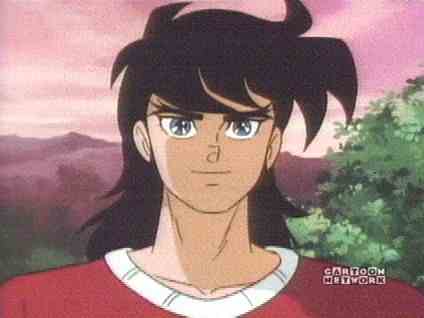 Ryo, Fire Warrior
in Samurai Troopers
Ryo, Fire Warrior
in Samurai Troopers
Colors:
There is a lot to say about the use of colors
in anime (since manga are usually black and white). The sharpness and color
combination of Japanese cartoons have a spectacular power and creativity
and makes them easily to recognizable (it is only fair to say that French
cartoons by Gaumont such as The Magician and Fantomette also
display excellent colors). Here, however, I will only highlight two aspects
of the symbolic use of colors: hair colors and the colors of "armors/fantasies"
of characters that wear special "clothes" when in action.
People not used to manga and anime aesthetics
usually notice two things in the first place: eyes size and hair color
or, better yet, hair colors : besides usual black, brown and blond
we are presented a profusion of shades of blue, green, pink, gray and white,
a despair for the adept to realistic drawing. Why do the characters have
such colorful hair? Is it a trick to draw attention? Would it be a secret
arrangement with ink manufacturers? Nothing of that.
I once read in a Brazilian animation magazine an answer to that question, and it was something like that: "all characters in anime and manga look very similar, so their hair color is a way to differentiate them."
Well, I agree that sometimes characters are really very similar, according to the artist's drawing style, but usually from one series to the other and not in the same series. And if a character's hair color is one of his personal traits, this is not the only reason. If it were so, characters would certainly have striped hair, or multicolor, or purplish with green dots... and that is not the case. The above-mentioned colors are practically the only ones used and for a very simple reason: besides differentiating the characters, colors give the audience information about their personality.
Hair is in itself a symbol of strength and
power. In Ancient Greece long, untied hair for men was considered a symbol
of liberty and nobility and this symbolism remains in manga and anime.
The exaggeratedly long hair of many characters accentuates their freedom
and power and lends them an aura of movement, nimbleness and mysticism.
On the other hand, characters that have short hair usually transmit an
image of austerity and functionality, of someone who cares less about his
appearance than about his actions (although that is not exactly the case
of Leiga in Shurato...).
 Ryo, Fire Warrior
in Samurai Troopers
Ryo, Fire Warrior
in Samurai Troopers
As for hair colors, the main character, the "hero", has most of the times black or very dark hair, probably for an identification of the (Japanese) audience with the character: black hair brings the main character's figure nearer to the reader/spectator's real world and everyday life and accentuates his image of a common human being (as already exposed previously on the page about heroes, that you can reach by clicking here). Black haired characters, even when secondary ones, are usually honest and straightforward and have great physical or moral strength. As for women, black hair usually stands for sincerity, moral strength and great dedication to their loved ones. Some well known examples for black haired characters are Seiya, Shiryuu and Shunrei (Saint Seiya), Raye (Sailor Mars, in Sailor Moon), Shurato and Ryuuma (Shurato), Goku and Chichi (Dragonball Z), Ash and Brock (Pokemon), Ryo (Ronin Wariors) or, for the "bad guys", Zagart and Alcion (Rayearth), Vegeta and Android 17 (Dragonball Z), among many others.
Using hair color for indicating personality traits is no novelty. In the West, blond hair is usually associated to angels, light and goodness. On the other hand, red hair often stands for a tendency to evil and wrath. As for women, it is said that men crave for blondes and marry brunettes, but are fascinated by the red-haired, which carry the fame of having a strong, passionate temperament.
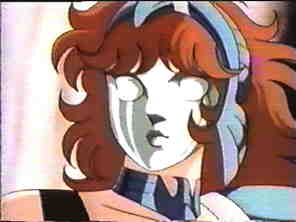 The
idea of "fire-colored" hair as indicating a strong female personality seems
to be the the rule in the imaginary of the mangaka (manga artists),
since red (or red-brown) is the preferred
color for female characters that show great strength, courage and determination.
Some examples are, among others, Lucy (Rayearth), Marin (Saint
Seiya), Misty (Pokemon) and Molly (Monster Rancher).
It is very interesting that red hair also often appears in male characters
that have a delicate body and an almost feminine beauty, which often cause
them to be mistaken for women,
The
idea of "fire-colored" hair as indicating a strong female personality seems
to be the the rule in the imaginary of the mangaka (manga artists),
since red (or red-brown) is the preferred
color for female characters that show great strength, courage and determination.
Some examples are, among others, Lucy (Rayearth), Marin (Saint
Seiya), Misty (Pokemon) and Molly (Monster Rancher).
It is very interesting that red hair also often appears in male characters
that have a delicate body and an almost feminine beauty, which often cause
them to be mistaken for women, 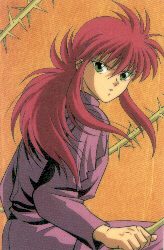 as
is the case for Kurama (Yu Yu Hakusho) and Kenshin (Rurouni Kenshin/Samurai
X). As for Kenshin, the mangaka himself comments that the real
man that was used as inspiration for the character was referred to as a
small and delicate warrior, that would often disguise as a woman.
as
is the case for Kurama (Yu Yu Hakusho) and Kenshin (Rurouni Kenshin/Samurai
X). As for Kenshin, the mangaka himself comments that the real
man that was used as inspiration for the character was referred to as a
small and delicate warrior, that would often disguise as a woman.
Blond hair
is also the cue for a character that is considered handsome/pretty. It
is the case of Hyouga (Cignus) in Saint Seiya (in a certain occasion,
Seiya tells Hyouga that he is the only one of the group that could be an
actor for his looks), of Leiga (Shurato), Gateau (Bakuretsu Hunter),
Zoicite and Sailor Venus (Sailor Moon), Android 18 (Dragonball
Z) and many  others.
Blond hair is also used to denote nobility, gentleness and aristocratic
manners, specially for women, as in the case of Amy and Princess Emerald
(Rayearth) or Vishnu (Shurato), but not only, as we can see
by Shaka (Saint Seiya) and Vega (Street Fighter II) . However,
hair that becomes blond (usually accompanied by a change in eye
color from black/brown to green or blue) stands for a gigantic increase
in a character's strength, as is the case of Karasu during the tournament
in Yu Yu Hakusho (Poltergeist Report) and Goku, Vegeta and
Trunks when going into Super Sayan (Dragonball Z).
others.
Blond hair is also used to denote nobility, gentleness and aristocratic
manners, specially for women, as in the case of Amy and Princess Emerald
(Rayearth) or Vishnu (Shurato), but not only, as we can see
by Shaka (Saint Seiya) and Vega (Street Fighter II) . However,
hair that becomes blond (usually accompanied by a change in eye
color from black/brown to green or blue) stands for a gigantic increase
in a character's strength, as is the case of Karasu during the tournament
in Yu Yu Hakusho (Poltergeist Report) and Goku, Vegeta and
Trunks when going into Super Sayan (Dragonball Z).
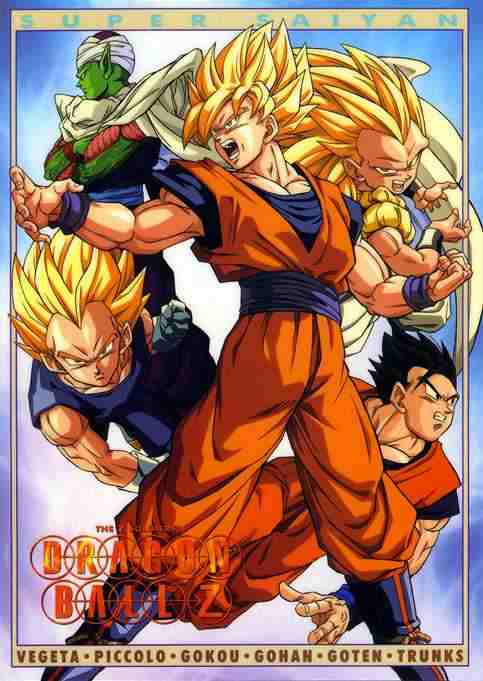
Goku, Vegeta e Trunks as Super Sayan
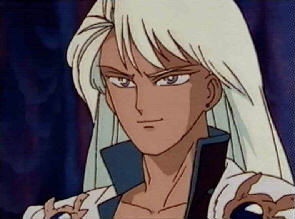 Another
very frequent hair color is white or grayish,
as that of Malachite/Kunzite in
Sailor Moon, Aries Mu in Saint
Seiya, Gai in Shurato or Inov em Rayearth. In the West,
gray or white hair is usually associated to old age and weakness. In manga
and anime the only common point with this idea is that characters who sport
this hair color have great spiritual power, intelligence and self-control,
attributes that, in the East, are associated to maturity. Such characters,
although extremely powerful, usually avoid fighting, rather try to impose
themselves by their wisdom and keep calm in any situation, although this
behavior many times has its roots in emotional dificulties that often make
them appear distant and cold.
Another
very frequent hair color is white or grayish,
as that of Malachite/Kunzite in
Sailor Moon, Aries Mu in Saint
Seiya, Gai in Shurato or Inov em Rayearth. In the West,
gray or white hair is usually associated to old age and weakness. In manga
and anime the only common point with this idea is that characters who sport
this hair color have great spiritual power, intelligence and self-control,
attributes that, in the East, are associated to maturity. Such characters,
although extremely powerful, usually avoid fighting, rather try to impose
themselves by their wisdom and keep calm in any situation, although this
behavior many times has its roots in emotional dificulties that often make
them appear distant and cold.
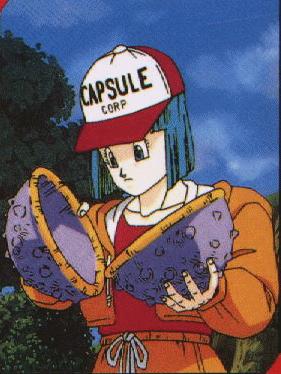 Contrary
to common sense, many characters have blue
hair and this color appears in the most variegated shades, from the nearly
black dark blue of Aquarius Camus (Saint Seiya) to the almost gray
blue of Marine (Rayearth), from Rowan's (Ronin Warriors)
deep blue to Bulma's faded one (Dragonball Z). A certain correspondence
can be noticed between the shade of blue and the power and personality
of the characters: the darker the shade, the greater the power, physical
strength or agressivity; the lighter the shade, the smaller the power and/or
the greater the sensibility.
Contrary
to common sense, many characters have blue
hair and this color appears in the most variegated shades, from the nearly
black dark blue of Aquarius Camus (Saint Seiya) to the almost gray
blue of Marine (Rayearth), from Rowan's (Ronin Warriors)
deep blue to Bulma's faded one (Dragonball Z). A certain correspondence
can be noticed between the shade of blue and the power and personality
of the characters: the darker the shade, the greater the power, physical
strength or agressivity; the lighter the shade, the smaller the power and/or
the greater the sensibility. 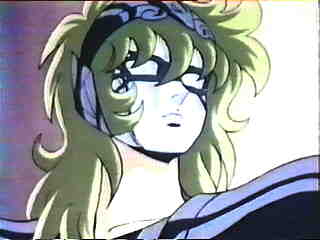 Light
blue hair is often used for female characters but it also appears in male
characters when their delicate nature is to be accentuated, as in Pisces
Aphrodite (Saint Seiya). The same goes for green
hair
as that of Andromeda Shun and Sheena (Saint Seiya).
Light
blue hair is often used for female characters but it also appears in male
characters when their delicate nature is to be accentuated, as in Pisces
Aphrodite (Saint Seiya). The same goes for green
hair
as that of Andromeda Shun and Sheena (Saint Seiya).

Rini, Serena's daughter in Sailor Moon
Dark or light brownhaired
characters are in a position between red and blond in the "power scale".
The color is usually destined to strong but moderate characters, as Hyouga
in Shurato. However, brunettes also present extreme behaviors, sometimes
impulsive and passional 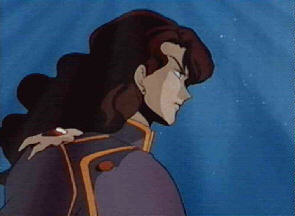 (as
Nefrite in Sailor Moon, Kuwabara in Yu Yu Hakusho),
(as
Nefrite in Sailor Moon, Kuwabara in Yu Yu Hakusho), 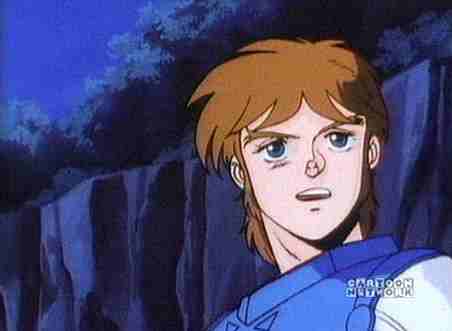 sometimes
quiet and sensitive (as Trowa in Gundam Wing and Sai in Ronin
Warriors).
sometimes
quiet and sensitive (as Trowa in Gundam Wing and Sai in Ronin
Warriors).
Nefrite, from Sailor
Moon
It is also interesting
to notice that in the first phase of Digimon I there is no black haired
main character, only diverse shades of brown and blond (and some red and
blue). This is most uncommon when compared to "older" series. Could it
be that the fact that Digimon I was created as a result of Pokemon's
huge mundial success has made it into an "export product", made for Western
audiences that would identify themselves more easily with brown haired
characters? The answer is blowing in the wind...
Clothes and armors
Something that really bothers me is, how do cartoon characters wear the same clothes day after day? (do they at least have them cleaned overnight?). In Dragonball Z there is an interesting allusion to that: while Goku is on board of the spaceship to Namekusei, we can see his closet full of... identical clothes! That is a weird taste for a wardrobe, but...
If hair color is distinctive for each character, what can we say about his clothes? In some series a character's clothes colors are part of his/her personality; he/she is even often referred to by it, as is the case of the Power Rangers, who are just called "Red Ranger" or "Pink Ranger". And even when they are not "morphed", the five teens always sport their respective colors in their daily clothes!
A fixed color set is intimately linked to groups of characters that "change their clothes" in order to assume their heroic personae. Those "clothes" can vary from soft tights (as in Power Rangers, Changemen, Flashmen and Sailor Moon) to magical (as in Saint Seiya, Ronin Warriors or Rayearth) or technological armors (as in Gundan Wing); the important thing is that each character usually keeps some correspondence between his/her daily attire and battle gear, being usually recognized through them (as in the Middle Ages, when the colors of a Knight's shield and clothes standed for his heritage and honor). And why? Because again, as for the hair, colors are used to transmit information about battle suits and those who wear them. Let's now see what the series Saint Seiya, Ronin Warriors, Sailor Moon, Power Rangers ("first generation") and Rayearth have in common.
In the first place, almost all these series focus on the adventures of five characters groups (except for Rayearth, of course, and some groups come to be expanded during the series). As already mentioned previously, the number five is perfect for depicting the union of different people under a leader in order to achieve common goals. I want to stress that the concept of difference is very important for the group unity: although they work as a team and have a common objective, each participant of these groups has his/her own characteristics that are revealed/antecipated by the colors they wear: red, green, blue, yellow, pink, white or black.
Colors have very different
meanings in different cultures. Just to give a classic example, while in
the West white is the color of peace and innocence, in the East it is associated
to death and mourning. While Western girls dream of marrying in white,
Spanish girls marry traditionally in black and no traditional Chinese girl
would think of marrying in other color than red. Just this will show that
sometimes very subtle messages can be conveyed, misinterpreted or even
go lost as to the use of colors. Thus, the comments I present here represent,
at the best, the point of view of a Brazilian Western woman about products
of Japanese Eastern culture. I was not yet able to research deeply about
color symbolism in Japan (sorry, maybe some other time!), but I think I
can risk some comments about the subject.
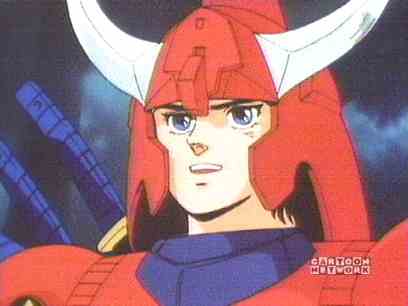 Ryo,
Fire Warrior in Ronin Warriors Ryo,
Fire Warrior in Ronin WarriorsAs already
mentioned, the figure of the leader is fundamental for such groups of characters
and the leader always receive the red armor (think of the clothes and armor
of Seiya, Ryo, Jason and Lucy and of Sailor Moon's ribbon). Red is associated
to fire and blood, this latter a symbol of life in the East. Thus, red
is the color that best suits the vital force, courage and passion necessary
to bring enterprises to an end without giving up or surrendering to the
adversities. In the case of Ryo and Lucy, the connection to the fire is
explicit, their armors |
Because of that, leaders need
a second-in-command, someone with a strength similar to theirs but more
controlled, less impulsive. To this second main character are alternatively
designed the colors green or blue, according
to the series, in my perception with a slight predominance of green.
|
Sage,
Light Warrior in Ronin Warriors Green is usually associated to nature, freshness, life and hope, as well as to spiritual enlightenment. The Chinese associate it to long life and wisdom. In the case of Saint Seiya and Power Rangers, green-clad characters (Shiryuu, Green Ranger) are the second in the hierarchy. They have the mission of using their power moderately and helping the leader when he exhausts his powers or is at his witt's end. In Sailor Moon, Ronin Warriors and Rayearth, the characters in green (Lita, Sage and Amy) are the third in the group hierarchy, although their power is not inferior to the characters that wear blue. |
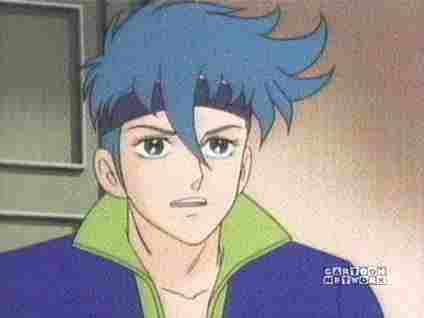 Rowan,
Sky Warrior in Ronin Warriors Rowan,
Sky Warrior in Ronin Warriors
In the case of Rayearth, Ronin Warriors and Sailor Moon, it is the task of the character wearing blue (respectively Marine, Rowan and Amy - Sailor Mercury) to second the leader. Blue is the color of sky and water, one of the most powerful elements: water can be the source either of life or destruction; it can move mansely or rise in storms and maelstroms; it can refresh in Summer or kill in Winter, in the form of snow and ice. It is a symbol for purity and transparency, truth and loyalty, but it also has the negative trait of an (at least apparent) emotional coldness. In Saint Seiya and Power Rangers the characters in blue (Hyouga and Billy) hold the third place in the group hierarchy. |
After the three "upper points" of the pentagram (the leader and his "arms") remain the two positions that constitute its base: the characters that wear yellow and pink. The function of these characters is to support the others, usually lending the group the necessary share of grace and stability. Yellow is often associated to gold, happiness, wealth and nobility as well as to the sun (a goddess in Japanese mythology). Pink is a mild color frequently associated to roses. I do not know if there is such a correspondence in Japanese imaginary, but pink is also the color of many flowers, usually associated to delicacy and love. In the West it is the traditional female color, but it does not seem to be the case in Japan (it is also good to mention that many male characters carry a rose as a symbol of their beauty and refinement). In Power Rangers, Changemen and similar series, yellow and pink are colors destined to the female members of the groups, but in Saint Seiya Shun is the one to wear a pink cloth (and also Ikki's cloth has a lot of pink).
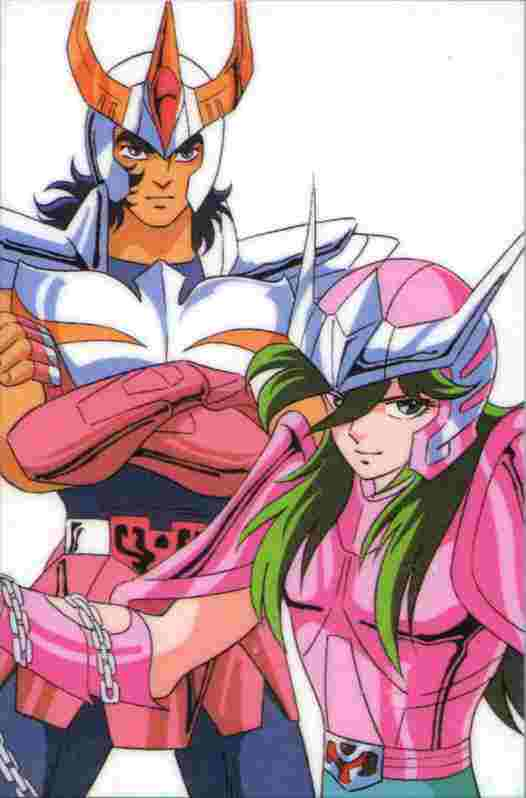
Ikki and Shun from Saint
Seiya
As for the Ronin Warriors,
the base is formed by Sai, that wears the Water armor, and Kento, that
has the Earth armor (this one is orange in color, in the tradition of yellow
and standing for endurance). In this series, the hierarchy is formed according
to five elements (fire, sky, light, water and earth) and this determined
a slight change in the color system (there are two blue armors, one for
the sky and one for water, which excluded a pink armor). 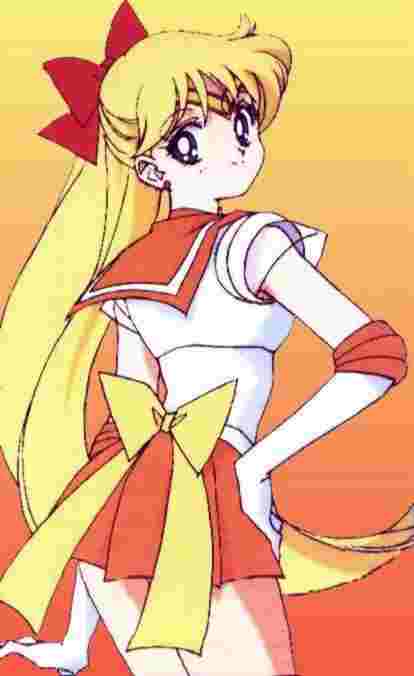 In
Sailor
Moon we have a duplication (or a splitting) in the color of the leader:
both Serena and Raye sport red elements, the first because she is the leader
and the second because of her guardian element, fire. Raye is the one to
stand for the fire because Sailor Moon's power do not base on action or
strength or blood shedding, but on compassion and cure. Thus, the figure
of the red leader was "split" in two and that excluded the pink figure,
since Mina (Sailor Venus) is blond and has a yellow ribbon in her uniform,
in accordance with the "traditional colors", and shares the base of the
group with Lita (Sailor Jupiter), who wears a green ribbon.
In
Sailor
Moon we have a duplication (or a splitting) in the color of the leader:
both Serena and Raye sport red elements, the first because she is the leader
and the second because of her guardian element, fire. Raye is the one to
stand for the fire because Sailor Moon's power do not base on action or
strength or blood shedding, but on compassion and cure. Thus, the figure
of the red leader was "split" in two and that excluded the pink figure,
since Mina (Sailor Venus) is blond and has a yellow ribbon in her uniform,
in accordance with the "traditional colors", and shares the base of the
group with Lita (Sailor Jupiter), who wears a green ribbon.
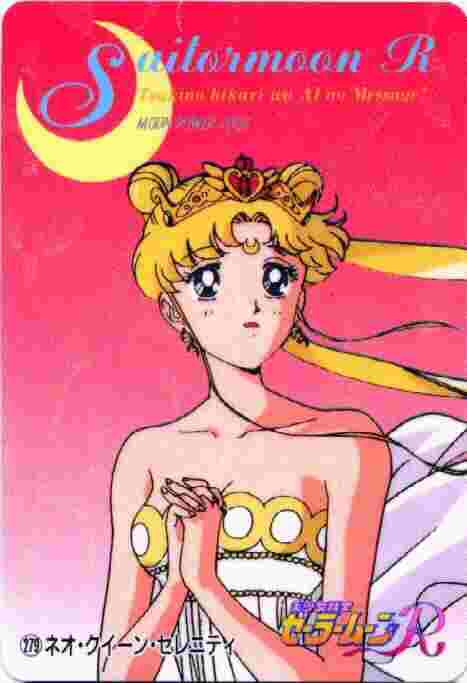 Since
we are talking about Sailor Moon, it must be noticed that she attains
her maximal power when she transforms into Princess Serenity, which wears...
white! White is the synthesis of all colors, as one can see by making white
light pass through a prism (the same principle that produces a rainbow,
when sunlight goes through raindrops that act as a prism - by the way,
this is also the name of one of Sailor Moon's attacks).
Since
we are talking about Sailor Moon, it must be noticed that she attains
her maximal power when she transforms into Princess Serenity, which wears...
white! White is the synthesis of all colors, as one can see by making white
light pass through a prism (the same principle that produces a rainbow,
when sunlight goes through raindrops that act as a prism - by the way,
this is also the name of one of Sailor Moon's attacks). In
this way, the character in white is in truth the most powerful, since he
stands for the synthesis of the group and has a power equivalent to the
sum of all of them. That becomes very clear when Tommy "morphs" into White
Ranger, when Serena transforms into Serenity and when Ryo receives the
white armor, all of them increasing their powers immensely.
In
this way, the character in white is in truth the most powerful, since he
stands for the synthesis of the group and has a power equivalent to the
sum of all of them. That becomes very clear when Tommy "morphs" into White
Ranger, when Serena transforms into Serenity and when Ryo receives the
white armor, all of them increasing their powers immensely.
In a few series, as in Power
Rangers, one of the main characters wears black and alternates with
the blue or green clad characters in the third place of group hierarchy.
In Power Rangers, the original order of the power trinity is red,
blue and black. The Green Ranger, that becomes the second in the hierarchy,
only joins them later in the series. In the West, black is associated
to death, darkness and sadness, but it also has a meaning of isolation
from the world to achieve a spiritual goal. Just as white is the synthesis
of all colors, black is the absence of them, the primeval emptiness from
where everything can emerge. However, there is no emphasis on this aspect
of black in the mentioned series (except, maybe, in Rayearth, where
Lantis, the isolated and taciturn brother of Zagat and ally to the Knights,
wears black). As we can see, although black is often the color wore by
the antagonists, as associated to the absence of light, there are also
"good guys" who wear it.
Problems, problems...
Colors and numbers carry so much symbolism that it is often difficult to understand it in products of different cultures. Before we get into closer contact with series such as the mentioned here, we usually do not pay attention to the hierarchy and the personality traits represented by them, or we may even misunderstand them: we find it strange that a male character wears pink or that a "good guy" dresses in black. We get irritated by the apparent lack of initiative of the group members, who seem unable to act without consulting the leader about what they should do and we do not understand the anguish and remorse of the leader for things that actually depend on his/her partners. But we soon "get the kick" and thus start to expect such symbolic schemes. And then we meet another kind of problem, the one arising from the mixture of cultures that occurs, for instance, in Power Rangers.
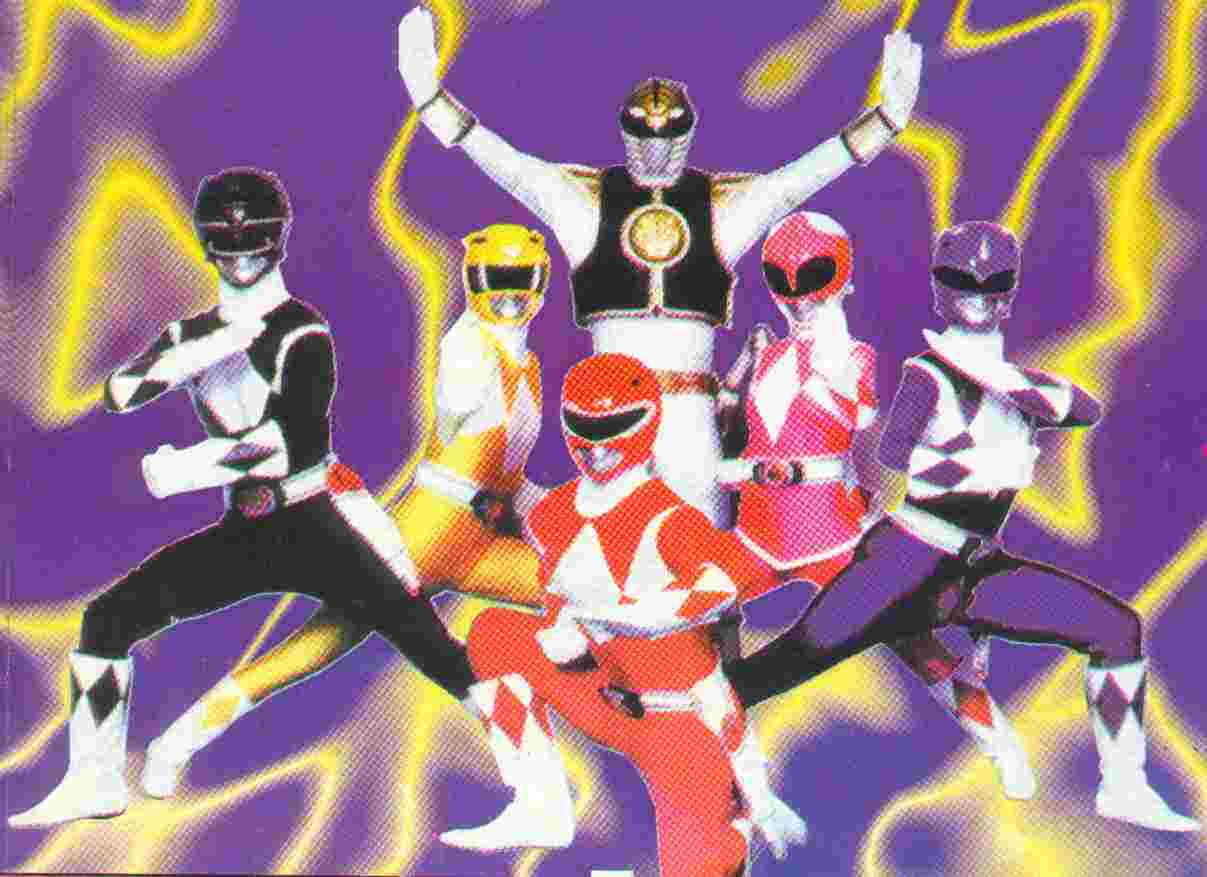
As everybody probably knows,
Power
Rangers is a "hybrid", a mixture of scenes from old Japanese series
and more recent scenes recorded specially for that in the USA, in an attempt
to approximate American audience to Japanese series (and here we have another
proof of how important it is for the characters to resemble the audience,
which probably determinates the black haired heroes in Japan and the substitution
of the original Japanese actors by the politically correct teens in Power
Rangers.) In the "first formation" of the group (in my humble opinion),
the American actors chosen for the roles are fairly adequate to the hierarchy
of the group in Japanese molds. However, also in my opinion (and that is
really a totally personal opinion, without any objective base), the selection
of actors for the later "formations" seems to have followed rather American
movies criteria than the Japanese hierarchy and it causes me a certain
discomfort: by usual Western standards, the leader must be a handsome (according
to the culture's standards), individualistic figure with traces of a super-man.
Thus, the American actor selected for the Red Ranger role in the "second
generation" of the series was probably chosen more for his looks than for
his martial and acting abilities. The result is a weak, discomposed "leader",
practically "carried" by the others in terms of presence in scene. I personally
see more "power" by original standards in the Black Ranger, which goes
totally against the color symbolism: black is the color for the third position,
so the Black Ranger could not be stronger than the leader - or else he
would become the leader and receive the red clothes. Situation is a little
bit better (always in my opinion) in Power Rangers in Space, but
it gets completely lost (now for the whole group) in Power Rangers in
the Lost Galaxy.
Maybe it is just my imagination,
but when one "gets the feeling" of Japanese productions one can't very
well digest falsified goods... Some people may say that if it were Brazilian
actors instead of Americans I would have no problems with the mixture of
scenes. Maybe, but in Brazil we are used to see such Japanese series in
the original and they enjoy great success among the audience, even with
Japanese actors. I think that exhibiting foreign series and films just
as they were conceived helps to develop a feeling and respect for other
people and cultures... It is not a case of xenophobia, I just have a strange
feeling of discomfort, a certain shock of being between two (or more) cultures
when watching in Brazil a Japanese series adapted to the USA and dubbed
in Portuguese...
Back to the first part of "colors and numbers": NUMBERS
Contact Elbereth! Comments are welcome!